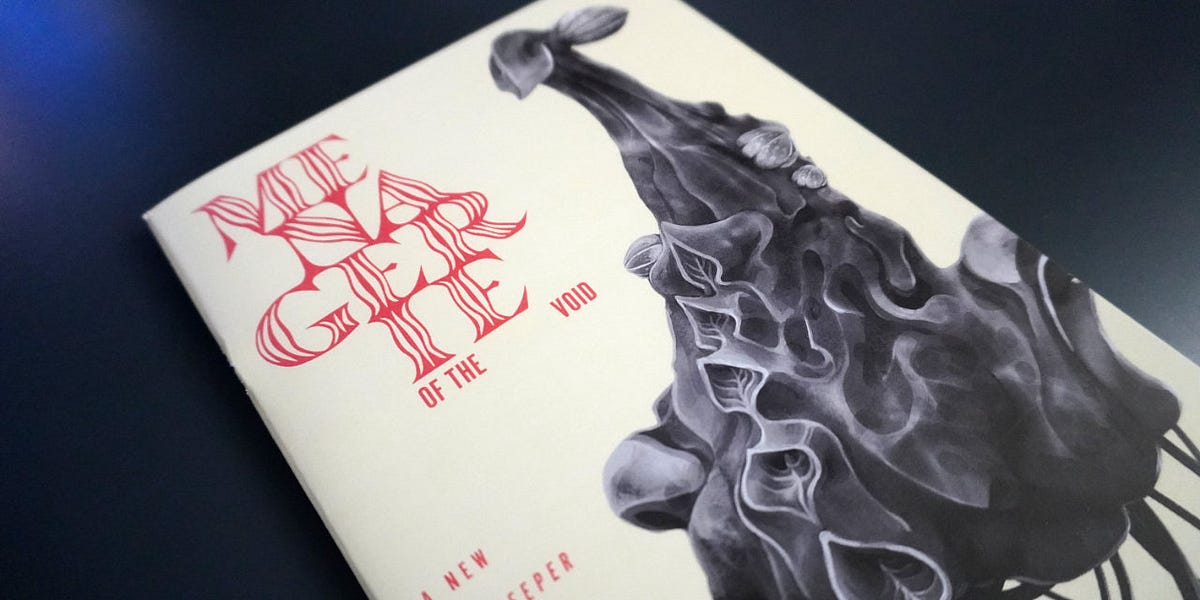SMOOSH JUICE
Tariffs, CanCon, and You

In 1972 the CBC asked listeners to complete the saying “As Canadian as…”, to match “As American as apple pie.” The winner was “As Canadian as possible under the circumstances.”
I never expected to use Canadianness as a selling point for RPGs. It never seemed relevant. It’d be like promoting them based my astrological sign or shoe size. And yet, here we are. It’s suddenly very relevant.
🍁To be clear, my books are unequivocally Canadian Content. They are written, designed, and printed in Canada.🍁
The Monster Overhaul and Magical Industrial Revolution are printed at Friesens in Manitoba. People have, rightly, complimented the print quality. I couldn’t be happier with how Friesens has handled these projects.
Currently, books are exempt from fluctuating US-CAN tariffs. Ink, paper, cardboard, etc. are not. Print costs haven’t risen yet, but they easily could for future print runs. I don’t do sales or discounts, so the books are unlikely to ever be cheaper than they are now.
At the moment, I intend to keep distributing my books via Indie Press Revolution in the USA. IPR has been great to work with, and it’s difficult to imagine them benefiting from or supporting current American policies.
I am, however, shifting more books to my Canadian distributor, Compose Dream Games. They’re also handling UK distribution, and ship worldwide. If you want books that don’t pass through American hands or American borders, order from them.
I designed both The Monster Overhaul and Magical Industrial Revolution for versatility. If A4 printers weren’t available, both books can be trimmed to letter-sized paper without impacting the text. Interior pages are black and white. The books don’t require die-cut cardboard tokens, plastic dice, trays, hand-assembled packages, chits, stickers, measuring devices, hourglasses, geegaws, gubbins, or tchotchkes. They’re just books.
I could have printed both books overseas. During the Kickstarter for the Monster Overhaul, I received several offers from fulfillment companies that work with Chinese printers (and one in Moldova, I think.) I’m sure the quality would have been the same, and the cost would have been much lower, but I don’t like extra moving parts in a project. Friesens is also an employee-owned company with a strong track record and excellent service.
That’s the relevant part of this post. Below the line, I’ve written a few thousand words about the motivations behind the current American tariff policy.
Moxy Früvous – Michigan Militia (1997)
Part 2: Why Tariffs? What Is The Plan?
Most RPG articles, such as Zach’s excellent summary on Goonhammer, focus on the practical reality of American tariff policy on the board game industry. While the Goonhammer article does great job covering the basics, there are specific aspects of these America’s tariff policy that deserve examination.
Ideally, someone competent would do it, but you’ve got me instead.
In November 2024, Stephen Miran released a document called “A User’s Guide to Restructuring the Global Trading System”. You can read it here (backup). In December 2024, Trump appointed Miran as chairman of the Council of Economic Advisers. On April 7th, Miran released a statement summing up his vision for a new global economic reality.
This is the economic equivalent of the Project 2025 plan. While it’s possibly hyperbolic to call Miran Trump’s Dr. Schacht, his work is very influential. The playbook is out. Any competent authority (an economic columnist, a central banker, etc.) that says they don’t understand what Trump is trying to do is either lying (possibly for good diplomatic reasons), talking down to you, or a fool.
There is considerable room for debate on whether or not Trump is succeeding at his economic goals (or what those goals are), but some potential goals, and corresponding pitfalls, are clearly laid out in Miran’s article. Is it a good or wise plan? Look, I’m not an expert. It is an intelligible plan. It has some internal logic. It is well worth reading. If you do read it, feel free to skip the rest of this post and draw your own conclusions.
Bear in mind that, just because there parts the paper make sense, the whole thing doesn’t need to make sense. Anyone can leaven bullshit with a few facts.
Restructuring the Global Trading System
The deep unhappiness with the prevailing economic order is rooted in persistent overvaluation of the dollar and asymmetric trade conditions. Such overvaluation makes U.S. exports less competitive, U.S. imports cheaper, and handicaps American manufacturing. -Miran, pg. 5
The world’s reserve currency is American dollars. Since dollars depreciate, countries often convert them into interest-yielding stable treasury securities. To facilitate trade and back up their currency, a country will therefore:
- Sell goods or their currency to America / a participant in the US-led global economy to get US dollars (USD).
- Either spend them immediately or buy an interest-bearing treasury security (UST) from the US Treasury.
While the US can’t directly set a county’s currency exchange rate, it has some influence over smaller economies through soft-power policies. More crucially, it gets to set the UST interest rate, which has a knock-on effect on all other bonds. Since the UST is traditionally seen as the safest possible investment, everyone else (in theory) has to offer better interest rates or more lucrative terms. It’s much more complicated in practice, but that’s beyond the scope of this post.
In Triffin world, the reserve asset producer must run persistent current account deficits as the flip side of exporting reserve assets. USTs become exported products which fuel the global trade system. In exporting USTs, America receives foreign currency, which is then spent, usually on imported goods. America runs large current account deficits not because it imports too much, but it imports too much because it must export USTs to provide reserve assets and facilitate global growth. -Miran, pg. 7
The flip side of this is called “market access”, i.e. the right of the USA to sell goods to a country or buy a country’s products. This is, traditionally, something the USA deploys military force to guarantee. “You give us your nice shiny cobalt and we’ll give you this piece of paper, which you can spend at our store, or with any of our global affiliates. We have a sale on rifles and helicopter gunships if you want to deal with some domestic cobalt-export-impeding threats.”
It’s also something the USA uses as leverage. “Play ball or we’ll cut off your access to the global marketplace.”
Miran wants to blow it all up. A full reset of the present order. The plan is to give up global market access and control of the world’s reserve currency in exchange for improved domestic manufacturing and spheres-of-influence arrangements with other great powers.
Think I’m being too cynical about the US’s use of military force? Miran doesn’t.
The U.S. dollar is the reserve asset in large part because America provides stability, liquidity, market depth and the rule of law. Those are related to the characteristics that make America powerful enough to project physical force worldwide and allow it to shape and defend the global international order. The history of intertwinement between reserve currency status and national security is long. In any possible reshaping of the global trading system, these linkages will become ever more explicit. -Miran, pg. 5
Take a look at the headlines.
- Stability? Hah. NATO is effectively dead, trade agreement mean nothing, tariffs change overnight, and the USA is threatening to invade half a dozen countries at once. What promises will be broken tomorrow?
- Liquidity? Look, I’m not the right person to ask, but probably? A politically pliable head of the Federal Reserve will turn on the money printer when asked and offer whatever loans are needed to whatever politically aligned entity requires them.
- Market depth? 10% of consumers account for over 50% of consumer spending. The majority of Americans live paycheque to paycheque. The stock market is propped up by an increasingly desperate series of Silicon Valley hype waves.
- The rule of law? I suppose that depends on whether or not you think of the law as a capital protection mechanism or a system of justice. If the former, you’re good. The property is safe. Your investments will be protected… probably. Miran does advocate for unilaterally and arbitrarily cancelling interest on foreign-owned treasury bonds (pg. 30), and the Trump administration has the ability to hoover money straight out of your bank account without warning or due process, so maaaybe put your money elsewhere.
Cheaper Borrowing?
The inference I draw from this is that while, all else equal, being a reserve currency may reduce borrowing costs, whatever benefit is gained is likely to be dwarfed by things like central bank policy outlooks, growth and inflation forecasts, and equity market performance. -Miran, pg. 9
This seems like a peculiar view. No other country has the money printer. This is usually called the exorbitant privilege. “It costs only a few cents for the Bureau of Engraving and Printing to produce a $100 bill, but other countries had to pony up $100 of actual goods in order to obtain one.”
This is, in theory, makes borrowing money extremely cheap. If the US wants to borrow 1 trillion dollars, it can instead print 1 trillion dollars. You can’t, and France can’t, but the Treasury can. The stable treasury security market also helps; even if they are paid for in foreign currency, it’s still a low-interest loan.
The interplay between reserve status and the loss of manufacturing jobs is sharpest during economic downturns. Because the reserve asset is “safe,” the dollar appreciates during recessions. By contrast, other nations’ currencies tend to depreciate when they go through an economic downturn. That means that when aggregate demand suffers a decline, pain in export sectors get compounded by a sharp erosion of competitiveness. Thus employment in manufacturing declines steeply during a recession in the United States, and then fails to recover materially afterward. -Miran, pg. 9
Not this recession. Congratulations Miran, you’ve done it! The US dollar is no longer the safe haven it once was. The plan is for the recovery to be less painful than past recessions, but, even if that works, what America is giving up in exchange seems… disproportionate.
“The Exporting Country Pays The Tariff”
“A tariff will be a tax on these foreign nations, these foreign companies, and if they want to be absolved of that tariff then they can come here to the United States of America to do business, bring their jobs here,” Press Secretary Karoline Kavitt, April 1st, 2025.
This comment was rightly mocked, but, if you read Miran’s paper, you can see the original phrasing that started this game of telephone. It’s perhaps asking too much for a press secretary to understand or explain this theory. The job of a press secretary is to distract, dissemble, and absorb criticism. Insight may be a handicap.
Tariffs and Currency Offset
The classic reason currencies offset changes in tariffs is that tariffs improve the trade balance, which then puts upward pressure on the currency for traditional reasons. But currencies might also adjust because nations’ central banks adjust interest rates to offset inflation and demand changes; or because end-supply is determined by comparative advantage and end-demand by preferences, and currencies adjust to offset changes like taxes; or because the growth prospects of the tariffing country improve relative to the tariffed country, attracting investment flows (so long as tariffs do not exceed “optimal” levels; see below).To illustrate the mechanism simply, let px be the price of a good charged by (foreign) exporters, denominated in their own currency, e the exchange rate (dollars per foreign currency unit), and τ the tariff rate. Then the price paid by (American) importers is: pm= e(1+ τ ) px
Suppose we begin with e=1 and τ=0. The government imposes a 10% duty on imports but the foreign currency depreciates by 10% as well. Then the price paid by importers becomes:
pm= 0.9(1.1) px=0.99px
In other words, the exchange rate move and the tariff almost completely offset each other. The after-tariff price of the import, denominated in dollars, didn’t change. If the after-tariff import price in dollars doesn’t change, there are minimal inflationary consequences for the American economy (but not so for the exporting country). -Miran, pg. 13
This is the sort of economics math that I truly, deeply hate. When sportswriter Jon Bois uses numbers to throw a fit, at least he sticks to football. Economists abuse high-school algebra in all sorts of stupid ways, disguising wishful thinking and pre-determined outcomes with greek letters and brackets. This isn’t a formula; it’s a prayer disguised as a promise.
That “if” in the bolded sentence is a load-bearing “if”. What if, instead of depreciating by 10%, the foreign country’s currency appreciates by 10% because of a central banking policy, Florida being levelled by a series of hurricanes, or the USD deprecating? Well, then the American importers lose twice. What if the the exporting country adjust px instead? Double loss. What if there’s any other additive variable such as increased freight charges, an export tax, etc.
Like inflation, the question of who bears the burden of the tariff will depend on what prices adjust, but there are more nuances. In a world of perfect currency offset, the effective price of imported goods doesn’t change, but since the exporter’s currency weakens, its real wealth and purchasing power decline. American consumers’ purchasing power isn’t affected, since the tariff and the currency move cancel each other out, but since the exporters’ citizens became poorer as a result of the currency move, the exporting nation “pays for” or bears the burden of the tax, while the U.S. Treasury collects the revenue.
[…]
By contrast, if currency offset does not occur, American consumers will suffer higher prices, and the tariff will be borne by them. Higher prices will, over time, incentivize a reconfiguration of supply chains. American producers will have improved competitiveness selling into the American market, and importers will be incentivized to find alternatives to the tariffed imports. As trade flows adjust, the trade balance can decline, but then the tariffs will no longer collect much revenue. -Miran, pg. 17
So you see, other countries will pay for the tariffs, through currency devaluation relative to the USD. Probably. Or, “over time”, it will all be fine. Don’t worry about it! It’s a good idea! Look at the nice equation I drew!
Let’s use a real-world example. Let’s say a board game company plans to print and assemble a board game in China. The game costs 73 yuan, or $10 USD, per unit. Let’s imagine there’s a 100% tariff on imports to the USA from China. It’s actually 104% as of today, but this make the math easier.
The board game company pays the manufacturer $10, ships the board game across the Pacific, cuts the US government a cheque for $10 for the tariff, and sells the board game for whatever they think the market will bear ($10 more than they would have sold it for without the tariff).
According to Miran’s proposal, if the yuan devalues relative to the US dollar, then the tariffs will cancel out. Instead of paying $10 for a board game and $10 in tariffs, the company would pay $5 to the manufacturer and $5 to the US government, so the $10 cost doesn’t change. The board game company isn’t any worse off, but China is, and the US government gets some walking-around money. It’s a great deal.
At a 100% tariff, this assumes that the value of the yuan will fall from 7.3 per USD to 14.6 per USD. That way, the board game would cost $5.
This also assumes that tariff rates stay stable. Over the past few months, they have not. A board game may cost $5 to print thanks to currency devaluation, but if the rate suddenly jumps to 250% between printing and shipping, then the company has to cut the US government a cheque for $12.50 and scramble to adjust the sale price accordingly.
The prices in this chart are inverted, but you get the idea of what a 50% drop in the yuan exchange rate would require, and how quickly it’d have to happen. For a 100% tariff to be “paid for”, it’d have to drop from 0.13 to 0.06.
Additionally, the manufacturer would have to keep price the same at 73 yuan… which they might do, or they might see that all their costs are increasing for knock-on reasons and decide to pass those costs along. Trans-pacific shipping costs would have to remain the same, which, given the decreased demand due to high tariffs, seems unlikely. Finally, the tariff is a paid to an entity that, on a direct level, had very little to do with anything in this process. And people hate paying taxes.
Wait, Isn’t Miran Trying to Devalue The Dollar?
You’re correct. If the point of the whole restructuring scheme is to devalue the dollar and reduce its viability as a global reserve asset in order to drive manufacturing back to the US (by making exports cheaper and imports more expensive), then any argument in the paper that relies on a strong US dollar (or devaluing other currencies) is impossible to justify. There’s no rest frame currency. Everything’s measured relative to the dollar.
I really hate economists. You can’t promise unlimited golden eggs and a roast goose in the same paper. Sure, there are caveats and alternative cases, but it’s still a horrible contradiction lurking at the paper’s core.
Why 104%+ Tariffs on China?
The simple answer is that it’s a trade war negotiating position. Trump likes to haggle and cut deals. This is leverage. But Miran has a more insidious proposal.
Similarly, imagine a very large tariff on China, say a sharp increase in the effective tariff rate from roughly 20% to roughly 50%, offset by a similar move in the currency. A 30% devaluation in the renminbi would most likely lead to significant market volatility. Because China’s communist economic system necessitates strict control over the capital account to keep funds locked in domestic assets, the incentives to find ways around capital controls could be devastating for their economy.
Capital outflows from China can potentially result in asset price collapses and severe financial stress. According to Bloomberg, total debt in the Chinese economy exceeds 350% of GDP (Figure 7); this level of leverage entails the possibility for massive vulnerabilities to leakages in the capital account. Bursting bubbles in China as a result of currency devaluation could cause financial market volatility significantly in excess of that caused by the tariffs themselves. -Miran, pg. 18
Ah, the “blow it up and watch ’em scurry” school of economics. Is the yuan devaluing? It’s early days yet. If I knew for sure, I could make a fortune. But, as of this post, it’s not falling off a 30% cliff, or showing any signs of doing so.
China Tariffs: Feb 1st, 10%. March 3rd, 20%. April 2, 54%. April 9th, 104%. Sure, there are corresponding wobbles, but Trump is mashing the “blow up China” button Miran gave him as hard as he can, and there’s no earth-shattering kaboom. Maybe those wires aren’t connected after all. All that capital that was supposed to flee… doesn’t seem to be fleeing. Or at least, it’s not fleeing China.
The Stock Market Rollercoaster
Stocks are up! Stocks are down! Panic! Don’t panic! Look, it doesn’t matter. Miran is a High Economist. The stock market is a tawdry sideshow seen from the Olympian peak of Central Banking.
 |
| S&P 500. This chart smooths out a lot of day-to-day swings. |
Tariff Implementation
A sudden shock to tariff rates of the size proposed can result in financial market volatility. That volatility can take place either through elevated uncertainty, higher inflation and the interest rates required to neutralize it, or via a stronger currency and knock-on effects thereof.President Trump, and those likely to staff his economic policy team, have a history of caring deeply about financial markets and citing the stock market as evidence of economic strength and the popularity of his policies. A second Trump Administration is likely therefore take steps to ensure large structural changes to the international tax code occur in ways that are minimally disruptive to markets and the economy. There are several steps that would help mitigate any adverse consequences. -Miran, pg. 21
You can check the steps Miran lists. Take a guess if Trump implemented them. Take a wild guess.
Graduated Implementation
Even in the 2018-2019 trade war, President Trump didn’t implement 25% tariffs on Chinese imports in one swoop with no warning. He discussed these plans publicly and threatened China if it didn’t reform its trade practices, before implementing tariffs. Subsequent to open threats, they were implemented in such a manner that the roughly 18-point increase in effective tariff rates was spread over more than a year. -Miran, pp. 21-22
I refer you to the article and date in the previous section… and Miran’s own advice that “a sharp increase in the effective tariff rate from roughly 20% to roughly 50% […] could be devastating for [China’s] economy.” (pg. 18).
Because tariffs are a negotiating tool, the President was mercurial in their implementation—the uncertainty over whether, when, and how big adds to leverage in a negotiation, by creating fear and doubt. -Miran, pg. 22
I seem to remember an economist talking about the values of stability, liquidity, market depth, and the rule of law. Was that Miran? Nah, couldn’t be that guy. Fear and doubt are great and promote investment in the USA. A “mercurial” president can be trusted to implement a total restructuring of the world’s balance of power and trade, and maintain a consistent policy in the face of inevitable internal and external opposition (as everyone from small investors to huge corporations lose their shirts in a market slump.)
In a second term, there’s less cause to negotiate with the Chinese up front, since they already abdicated their responsibilities under the Phase 1 agreement. When someone has already demonstrated they walk away from their commitments, why bother trying to procure more, without some form of security—like placing their UST reserves in escrow? -Miran, pg. 22
Yes, it’s funny how walking away from commitments can lead to serious consequences. How odd. How peculiar. And it’s not like Miran is an advocate of sudden unilateral and potentially illegal actions, such as placing a country’s purchased UST reserves in escrow (pg. 22), or denying interest payments on UST reserves if a country doesn’t toe the line (pg. 30).
If the system is effective over time either at raising revenue or incentivizing more favorable treatment from trading partners, it could eventually have a top tariff rate significantly in excess of 10%, that applies to a small number of countries. Similar to the domestic tax code, once the government starts carving out exclusions and deductions for various behaviors, it needs to raise rates to achieve the same revenue goals. -Miran, pg. 23
In other words, “Kneel early or get left holding the bag.” You don’t want to be the last country standing in this game of tariff musical chairs.
Such a system can embody the view that national security and trade are joined at the hip. Trade terms can be a means of procuring better security outcomes and burden sharing. In Bessent’s words, “more clearly segmenting the international economy into zones based on common security and economic systems would help … highlight the persistence of imbalances and introduce more friction points to deal with them.” Countries that want to be inside the defense umbrella must also be inside the fair trade umbrella. -Miran, pg. 23
“Fair trade” in a very limited and largely ahistorical sense. Perhaps we should call it a sphere of influence or an imperial market. Quick! Get your coloured pencils and draw what you think the “zones of common security and economic systems” ought to be. I’m going to put Scotland, Wales, and a united Ireland in the E.U. for fun. England can be “sad nuclear rump state grey.”
Such a tool can be used to pressure other nations to join our tariffs against China, creating a multilateral approach toward tariffs. Forced to choose between facing a tariff on their exports to the American consumer or applying tariffs to their imports from China, which will they choose? It depends on the relative tariff rates and how significant each is to their economies and security. The attempt to create a global tariff wall around China would increase the pressure on China to reform its economic system, at the risk of significantly more global volatility as supply chains come under greater pressure to adjust. -Miran, pg 23
It’s important, if you’re going to blackmail people, not to act like a lunatic who might release the blackmail material even if paid, or leave it on a bus stop, or attack your victim with a hatchet. Consistency is important.
“Reform its economic system” is one of those euphemisms like “liquidate the population” or “remove barriers to trade” that gives me cold shivers.
Because of the emphasis on competitiveness, it is unlikely that a second Trump Administration will support an increase in domestic tax rates, whether corporate or income. Its goal will be, in large part, to make America a more attractive place to invest and hire than other countries, particularly China, and higher domestic tax rates undermine that goal. -Miran, pg. 24
Your 401k is gone? Your company is laying off thousands of workers? Excellent. Get back to work, or die sooner. What do you think “making American labour competitive” means for the average worker? If the cost of American labour is already too high, according to Miran, what bits do you think they’ll carve off? Unions? Gone. Worker protections? Gone. Social Security? Gone. Mussolini wanted to bring back guilds; has Miran considered that?
For example, suppose a taxpayer reduces her working hours from 45 per week to 40 per week because her income tax rate increased. While she enjoys more leisure, the goods or services she would have produced in those five hours, and the salary she would have received, cease to exist and are lost to the economy forever. The “deadweight loss” or “excess burden” in this stylized example is the lost production, net of the increased leisure she enjoys and revenue raised by the government. -Miran, pg. 24
Has Stephen Miran ever worked a 40-hour week, let alone a 45-hour week? Is Stephen Miran aware that workers rarely get to adjust or set their own hours? Is he aware that a consistent 40-hour work week is, for many Americans, a wonderful dream? Does he know how how tax brackets work?
I’m not convinced. And if you think Stephen Miran’s thoughts on the lives of workers are muddled neo-Reaganism, you have to wonder what else he’s muddled about.
Additionally, it’s not clear whether one should view the failure of this deterrent as a bad outcome. Suppose the U.S. levels tariffs on NATO partners and threatens to weaken its NATO joint defense obligations if it is hit with retaliatory tariffs. If Europe retaliates but dramatically boosts its own defense expenditures and capabilities, alleviating the United States’ burden for global security and threatening less overextension of our capabilities, it will have accomplished several goals. Europe taking a greater role in its own defense allows the U.S. to concentrate more on China, which is a far greater economic and national security threat to America than Russia is, while generating revenue. -Miran, pg. 26
This is an amazing paragraph to unpack. Bear in mind it was written in November of 2024. It:
- Assumes that Europe and the USA will remain amicable.
- Seems to assume that Europe will spend some of its defense funds in the USA.
- Assumes that a hot (or tepid) war with China is both desirable, winnable, and profitable, which is… well, it’s definitely a position a hedge fund manager and disciple of Martin Feldstein would come up with.
Bond Market Shenanigans
Currency policy brings different considerations than tariffs do. The principal risk of pursuing a fairly valued dollar is that the policy intervention makes dollar assets less attractive in the eyes of foreign investors. At the time of writing, the yield on ten-year UST debt is roughly 4.25% per year. Suppose movement towards the currency valuation that would arise in a trade balance equilibrium would result in foreign holders of USTs expecting a 15% reduction in the domestic value of their UST holdings: that represents almost four years’ worth of interest payments, and over a third of all the expected interest over the life of the note. Three-year UST debt yields 4.1%, implying the devaluation would eat more than all expected interest, i.e. the note holder loses money over the life of the security.
These risks can be a disincentive for holding dollar-denominated fixed income securities. If an expected change in currency values leads to large-scale outflows from the Treasury market, at a time of growing fiscal deficits and still-present inflation risk, it could cause long yields to rise. Because significant portions of the economy—like housing—are tied to the belly and long end of the yield curve, such a rise could have material adverse consequences.
This is what we saw in the bond market swings of the last few weeks… possibly. Or possibly it’s arbitrage traders liquidating their UST collateral positions. It’s all a terribly complicated mess.
Let’s break it down a bit more. The US treasury is able to offer low interest rate securities because they’re stable. People know they’ll pay out. Sure, not as much as gambling at the stock market casino, but if you gamble you can lose your money. Securities are, as the name implies, safe… or at least safer. And the UST is the safest of all.
In simple (i.e. almost completely wrong) terms, every day, the US Treasury opens its doors and goes, “Coo-eeee, I’ve got some lovely contracts to sell. Give me $100 now and I’ll give you $103 later.”
In times of panic, traditionally, the door is crowded with buyers, and the Treasury can say, “I’ll give you $102 later, or $101” and still find buyers desperate to put their money somewhere it will grow instead of shrink (or vanish.)
If there are no buyers, which is rare, then the Treasury has to go. “Come on, folks. $104 later. $105?”
Since UST sells billions of securities at once, and they pay out over ten years, that extra dollar or two really, really adds up. More outflows means printing more USD (because tariff revenue is a drop in the bucket compared to security market moves), which means more inflation (as each new dollar makes existing dollars worth less), which leads to a devalued USD (which Miran wants), which makes low-interest securities less attractive (as investors want to keep up with or beat inflation), which means the Treasury has to offer higher yields… and around and around we go.
 |
| 10 Year Note Bond Yield |
This risk will be somewhat compounded if inflation remains elevated. As discussed in the section on tariffs, the results in Gopinath (2015) indicate that a 20% depreciation in the dollar would boost CPI inflation by 60-100 basis points. A one-time adjustment in the currency without second-round effects should be looked through by the Fed as a price-level rather than inflation-rate shift. However if the Fed believed it to persistently shift the rate of inflation rather than just the price level, under standard Taylor rule specifications, it would hike overnight rates by roughly 100-150 basis points.
Even assuming that’s justifiable (which is…. well, economics isn’t a science) those are some worrying numbers. For reference, CPI was 251 basis points in January of 2020 (pre-Covid) and is 320 basis points now. That’s a rise of 69 basis points. Not nice. If you’re an American, imagine the last 5 years of price increases, but crammed into a sudden burst, while other factors are driving wages to the floor. Good luck!
Nobody Likes Being Called Cheap
Cheap labour and deregulation seems to be the neo-Reaganite line Miran is following. But it’s not the technocratic line J.D. Vance usually spouts.
There were two conceits that our leadership class had when it came to globalization. The first is assuming that we can separate the making of things from the design of things. The idea of globalization was that rich countries would move further up the value chain, while the poor countries made the simpler things.
[…]
But I think we got it wrong. It turns out that the geographies that do the manufacturing get awfully good at the designing of things. There are network effects, as you all well understand. The firms that design products work with firms that manufacture. They share intellectual property. They share best practices. And they even sometimes share critical employees.
Now, we assumed that other nations would always trail us in the value chain, but it turns out that as they got better at the low end of the value chain, they also started catching up on the higher end. We were squeezed from both ends. Now, that was the first conceit of globalization.
I think the second is that cheap labor is fundamentally a crutch, and it’s a crutch that inhibits innovation. I might even say that it’s a drug that too many American firms got addicted to. Now, if you can make a product more cheaply, it’s far too easy to do that rather than to innovate.
And whether we were offshoring factories to cheap labor economies or importing cheap labor through our immigration system, cheap labor became the drug of Western economies.
And I’d say that if you look in nearly every country, from Canada to the UK, that imported large amounts of cheap labor, you’ve seen productivity stagnate. I don’t think that’s — that’s not a total happenstance. I think that the connection is very direct.
Ah, the power of nebulous “innovation.” The last decade of Silicon Valley innovation has been bust after bust, burning through mountains of cash with nothing to show for it. Virtual reality, NFTs and crypto, LLM AI. All niche, all unprofitable, all struggling to scale past a kernel of cultists. Strip the hype-dominated tech stocks and AI shovel-sellers out of the market and growth is stagnant or declining.
There are no easy fields of investment. No iron ore seams that need a smelter, no underserved towns that need a railroad. All the blank spaces on the map are filled in. Everyone who can afford one has a refrigerator and a cell phone. In the absence of fields for growth, companies cannibalize, selling off the land under hospitals and peddling pipe dreams.
Also, innovation, cheap labour, and deregulation is better than innovation alone, if you can get it.
Moreover, because reducing inflation is critical to helping alleviate bond market concerns as well as allowing the Fed to pursue a deeper cutting cycle, a Trump Administration is likely to prioritize structural policies that reduce inflation via supply side liberalization. That means aggressive deregulation, and a concentrated effort to reduce energy prices. This combination is probably bearish oil prices, but ambiguous for energy producers, and quite bullish for equities and growth. If deregulation boosts potential growth and reduces inflation—as this contributed to the noninflationary growth experienced in the first Trump Administration—that will help support both the bond and equity markets. -Miran, pg. 36
Trump’s blood-and-soil immigration policies are shrinking the labour pool, which, in theory, could drive up wages. Massive federal government layoffs, anti-union measures, repressive and arbitrary law enforcement, collapsing safety nets, and child labour will drive wages down. Lowering income taxes drives real wages up; the CPI increase projected by Miran due to USD devaluation and tariffs eats that gain and more for anyone who doesn’t own a yacht or two. And it’s all academic if you vanish into an offshore prison or get drafted for a hot war.
Now, one of the debates you hear on the minimum wage, for instance, is that increases in the minimum wage force firms to automate. So, a higher wage at McDonald’s means more kiosks. And whatever your views on the wisdom of the minimum wage — I’m not going to comment on that here — companies innovating in the absence of cheap labor is a good thing.
I think most of you are not worried about getting cheaper and cheaper labor. You’re worried about innovating, about building new things, about — the old formulation of technology is doing more with less. You guys are all trying to do more with less every single day.
When McDonalds replaces a checkout worker with a kiosk, where does that worker go? That doesn’t seem to be of interest to Vance or his audience. This administration is interested in “prosperity” and “order” in the macro sense. An antebellum cotton plantation is prosperous and orderly. The fate of individuals is irrelevant.
In Conclusion
Stephen Miran built an experimental airplane. It could fly. It could explode on the runway. It could be no better than its rivals. He then then handed the controls to people who have never flow before. Some don’t believe in airplanes. Some are actively dismantling the instruments that would ordinarily detect if the flight is successful or not.
This is not a crisis of the dollar. The dollar is behaving as expected. When you see:
- The USD devaluing compared to other currencies.
- Wild fluctuations in the stock market.
- Other countries buying fewer US treasury bonds (resulting in higher interest rates / more debt).
- Fees/taxes/interest rate penalties on countries that own UST reserves.
- Naked extortion of countries outside the US’s sphere of influence.
- Sudden spikes in tariff rates on China (or other countries that Trump wishes to destabilize).
- Rising prices on consumer goods caused by tariffs and the devaluation of the US dollar.
- An increasingly fragmented, multipolar world, where great powers are free to enforce their will without US economic or military interference (provided they offer tribute).
Know that it’s all part of the plan. It’s not an unintentional side-effect of some badly implemented or muddled policy. It is the policy. It is being implemented. Its effects, as intended, cannot be walked back by a future administration or a sudden change in priorities. Doubt and fear are priced in.












